This huge Majora’s Mask interview was published in The 64 Dream issue #45 from June 2000.
Archived magazine here: https://shorturl.at/bchI3
Translated by
Frank: https://www.instagram.com/frank_eats_food
Formatted by
Javed Sterritt: https://twitter.com/JavedLSterritt
Please consider supporting to allow us to keep up the translation work: https://www.patreon.com/goodblood
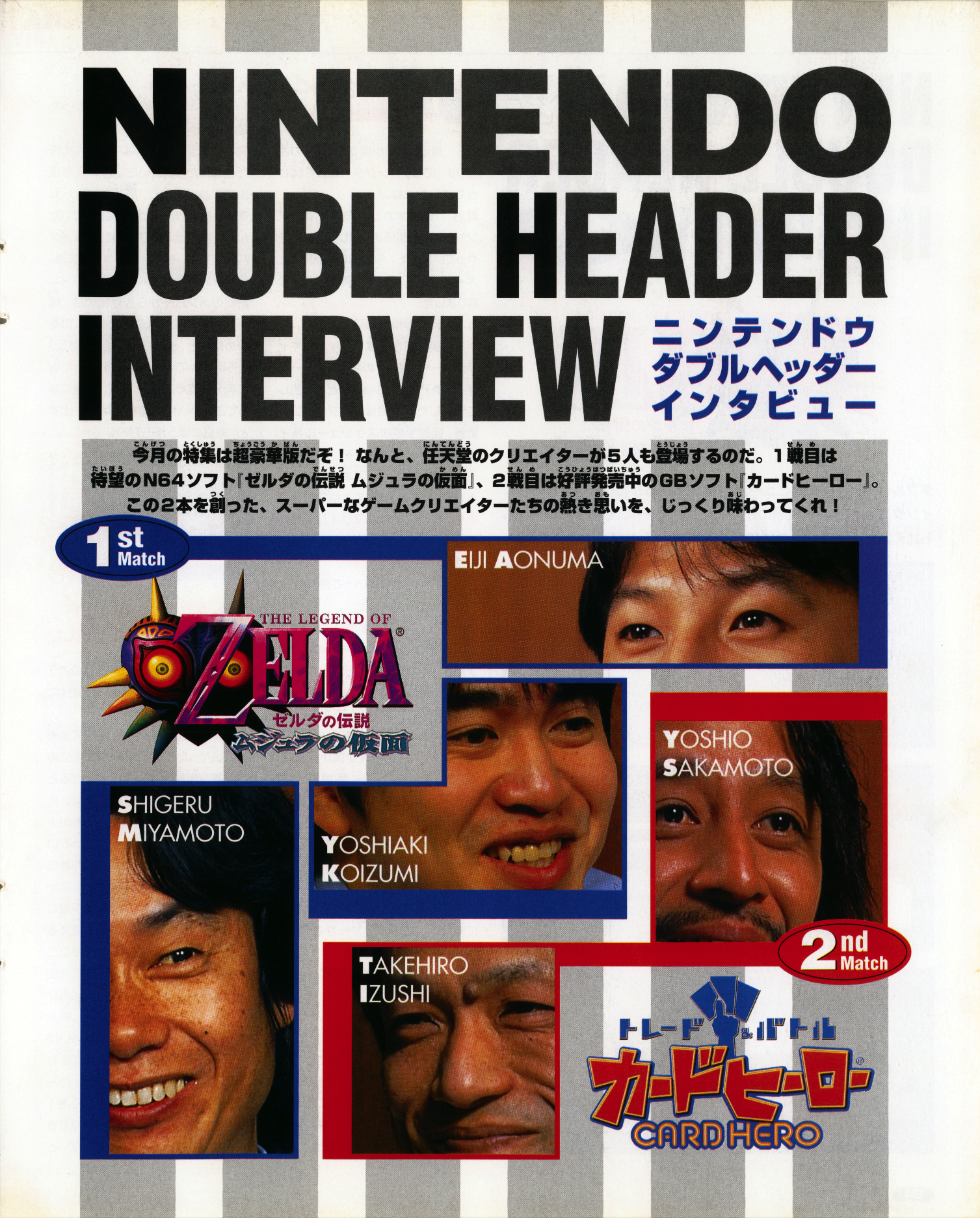
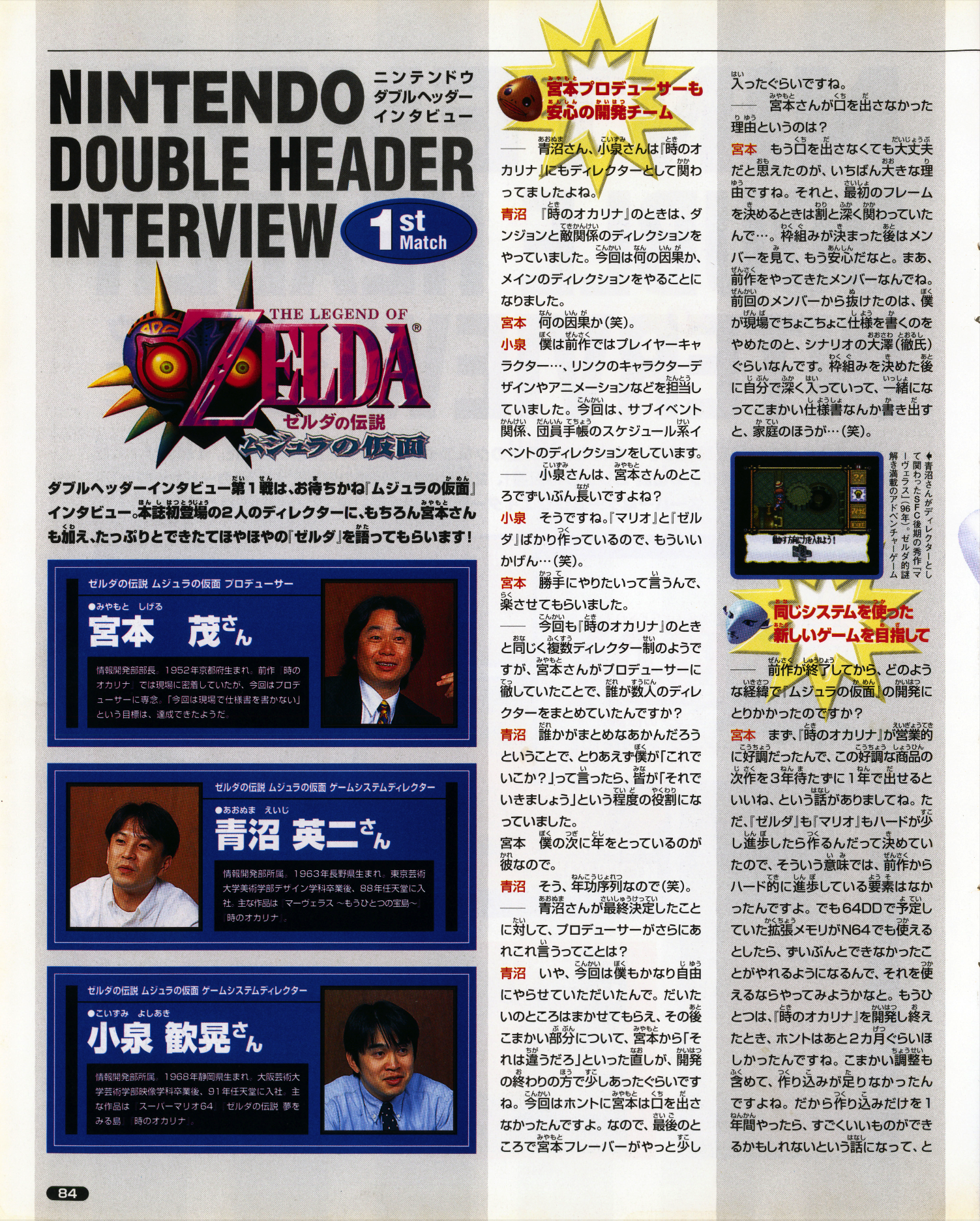
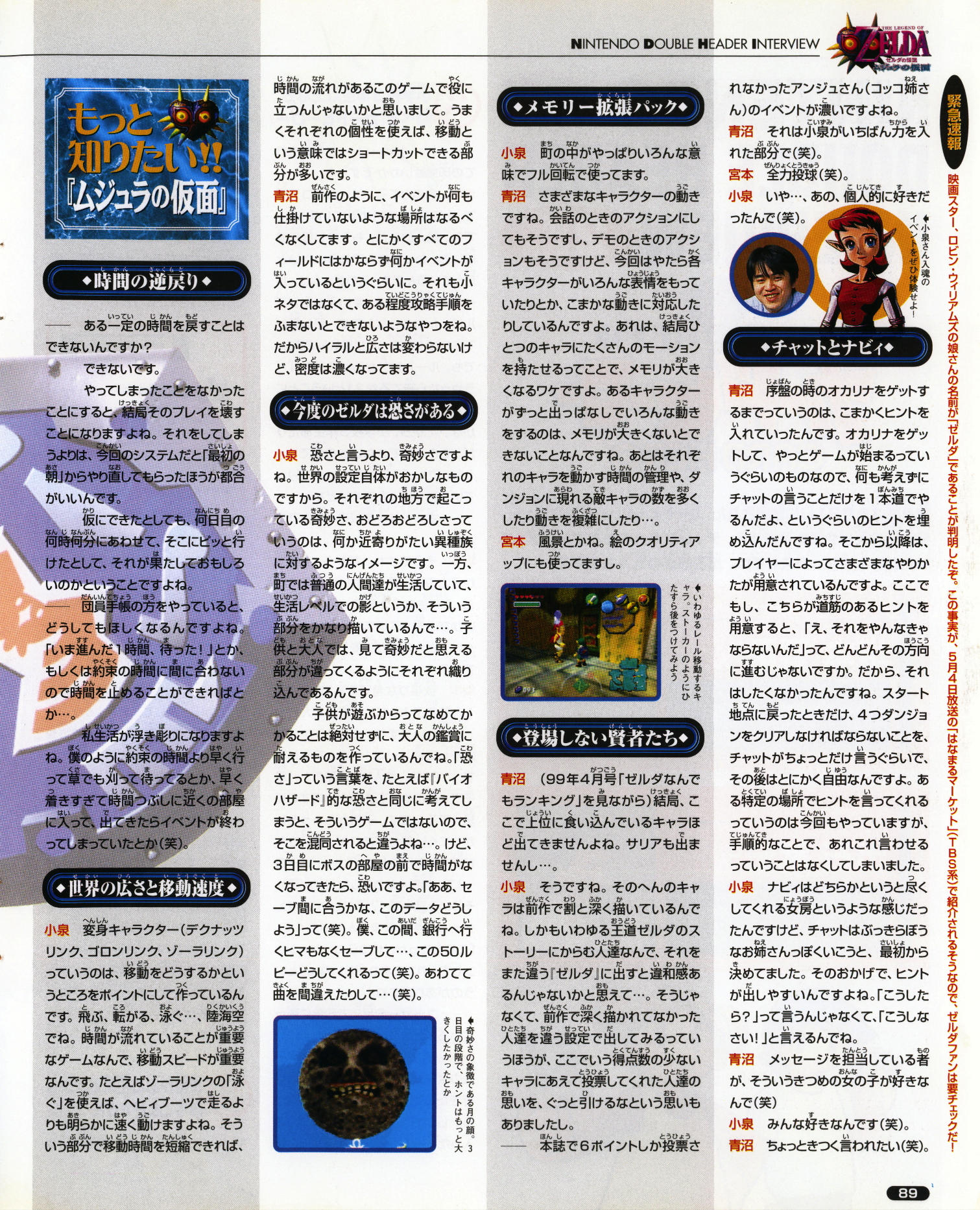
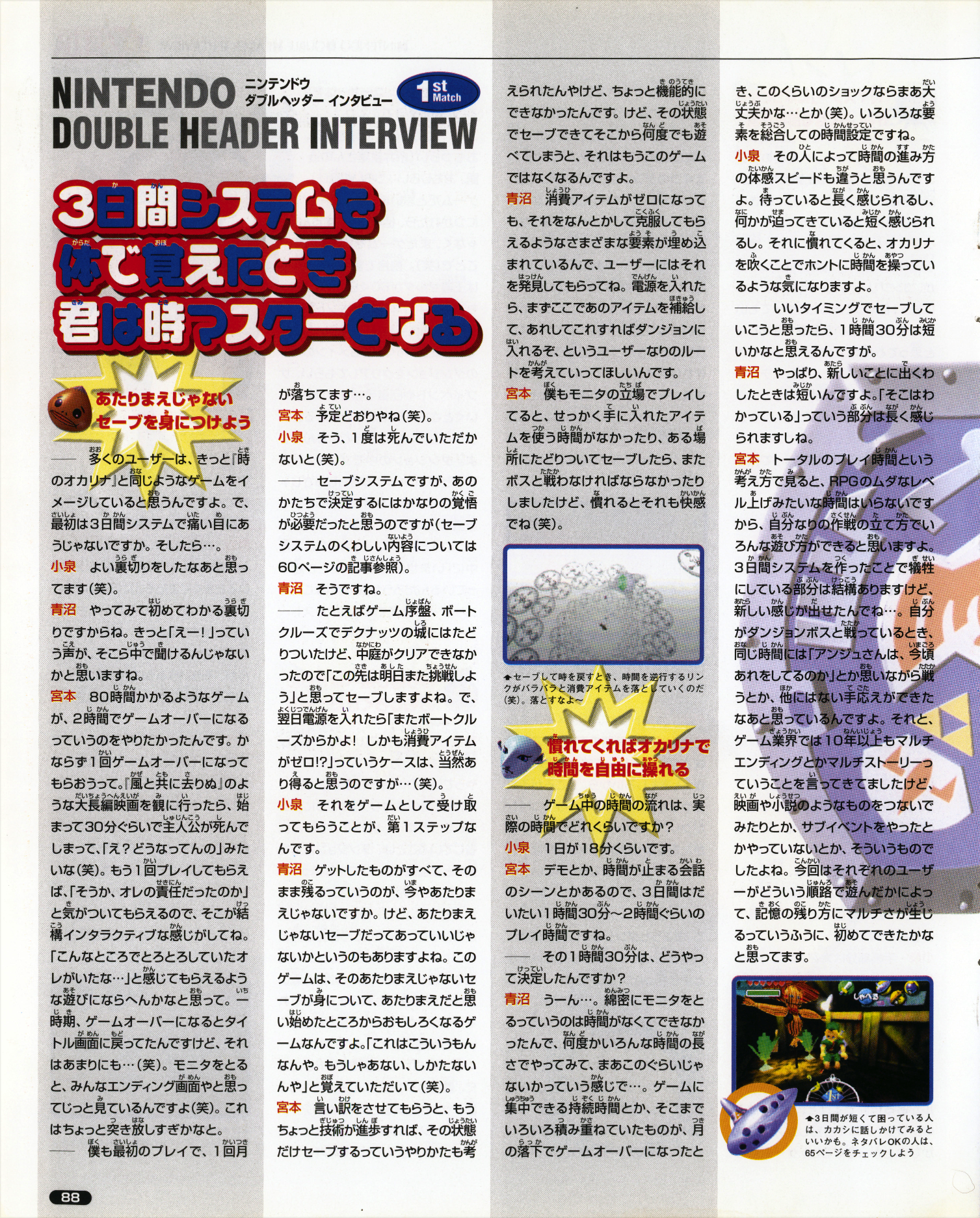
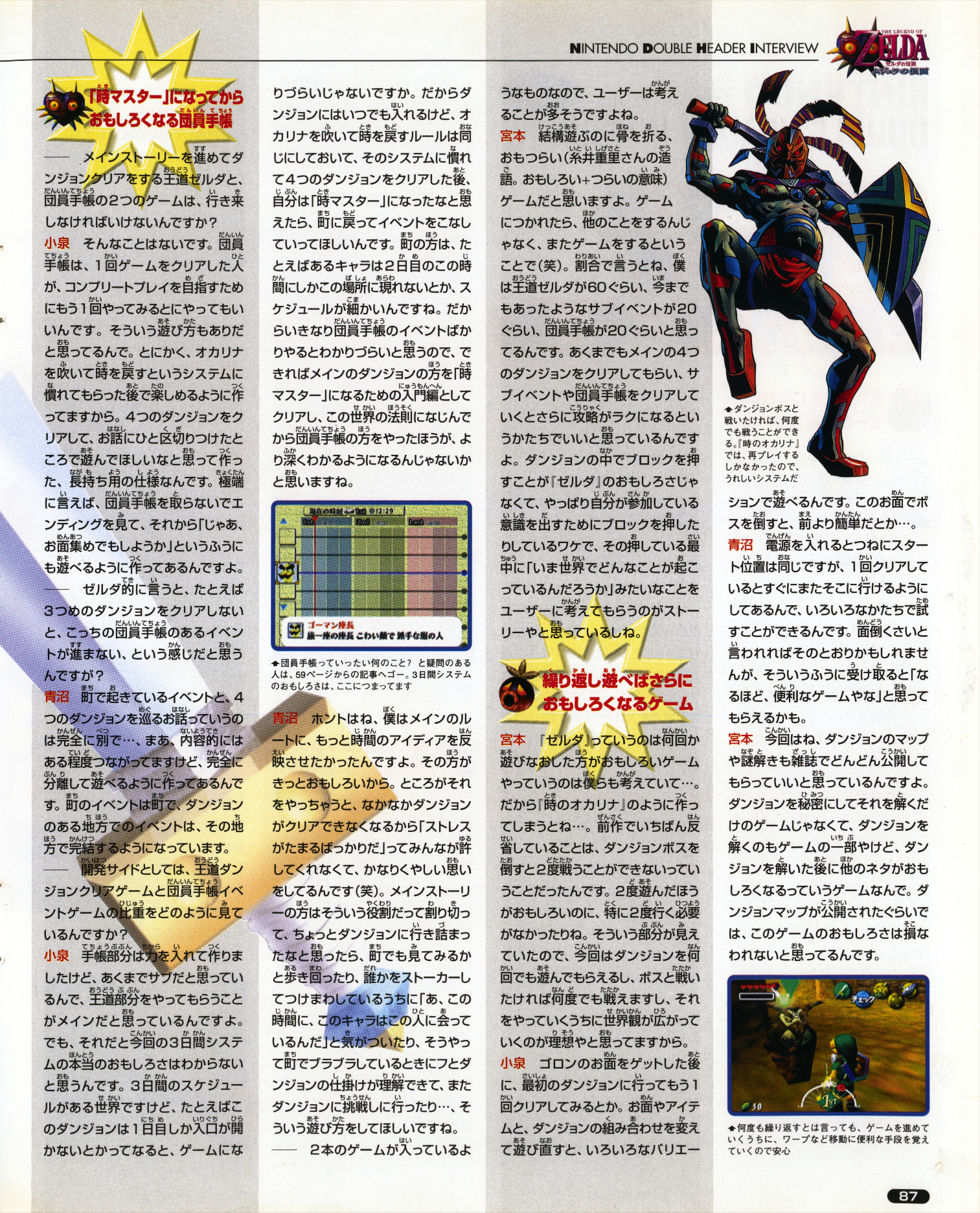
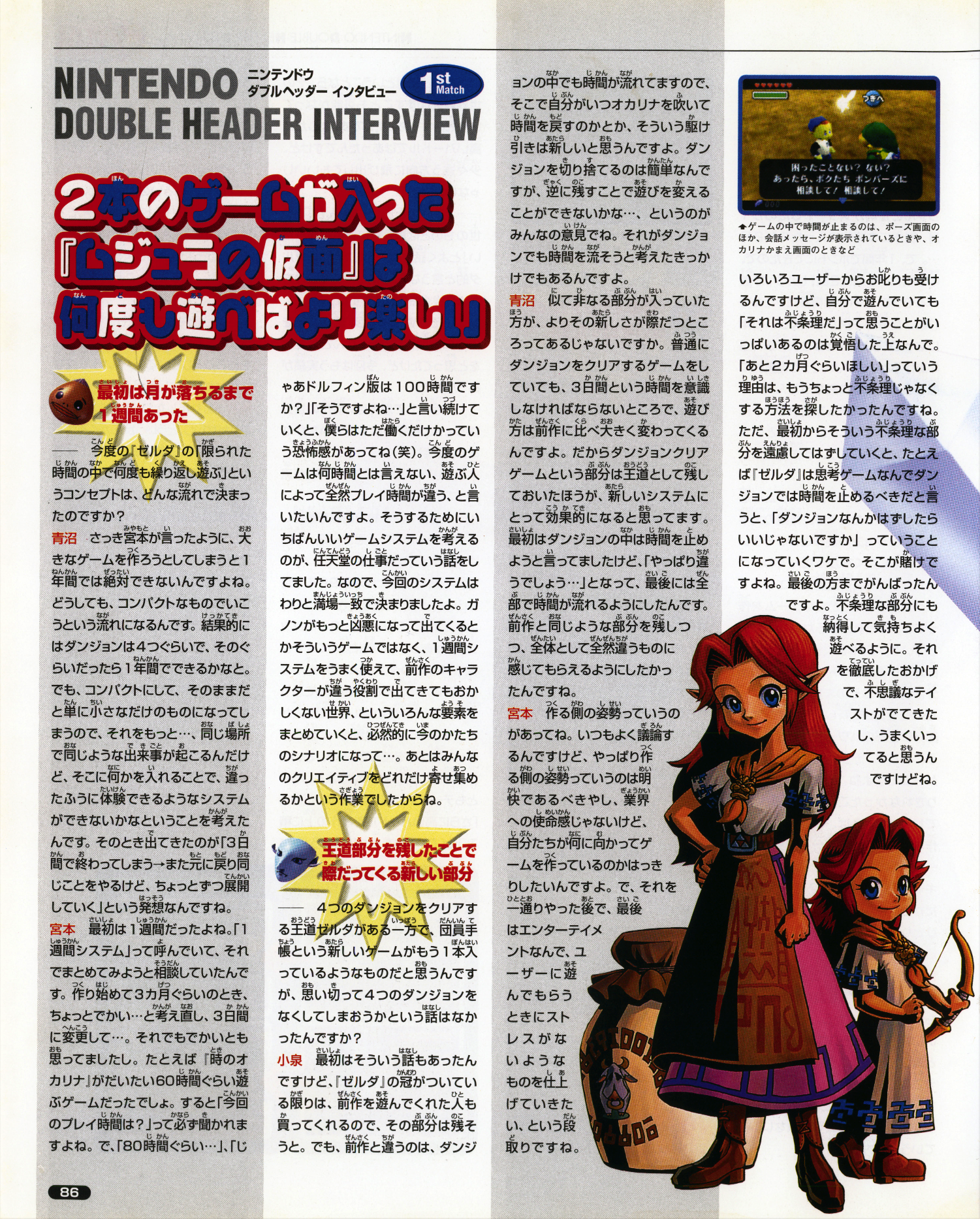
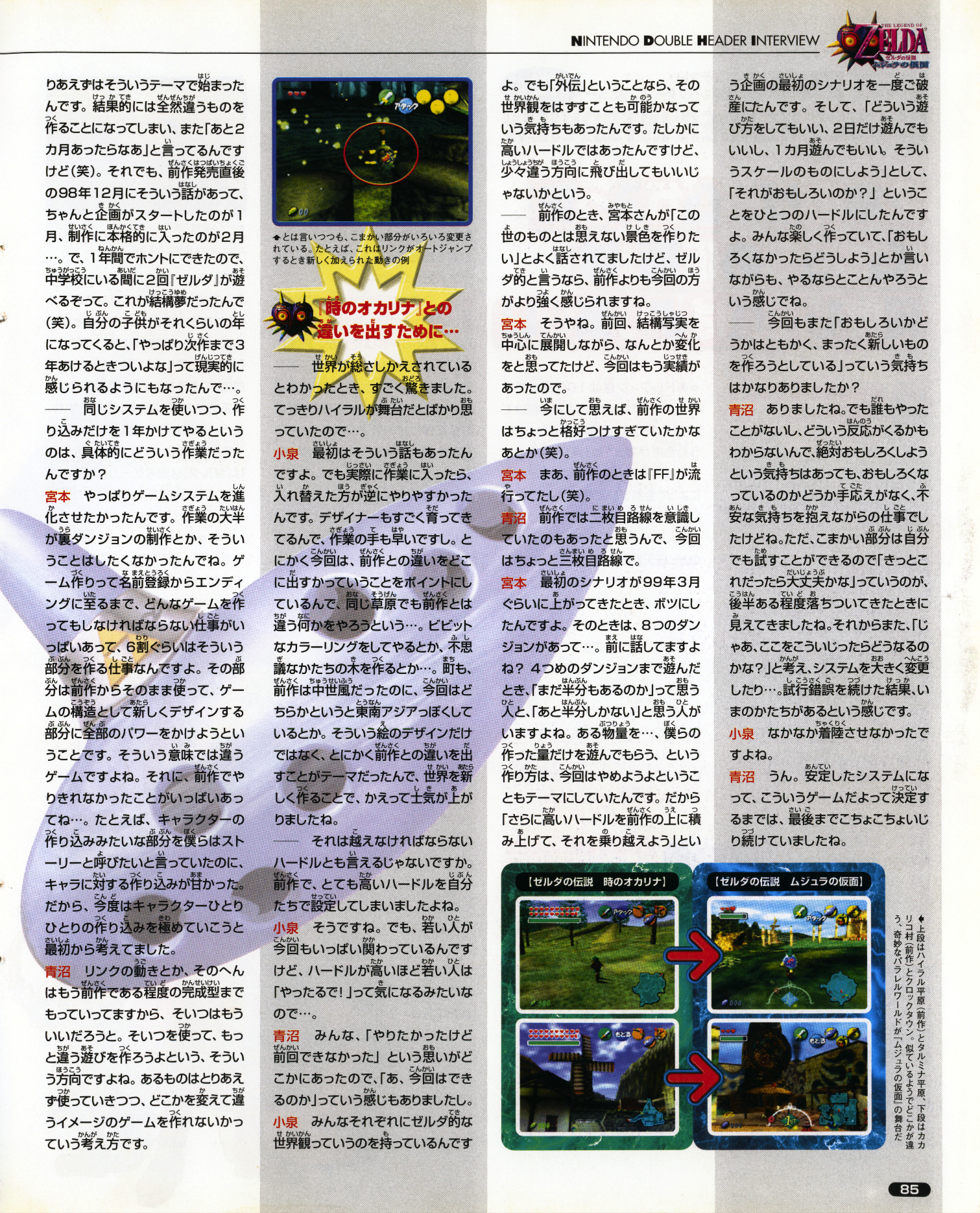
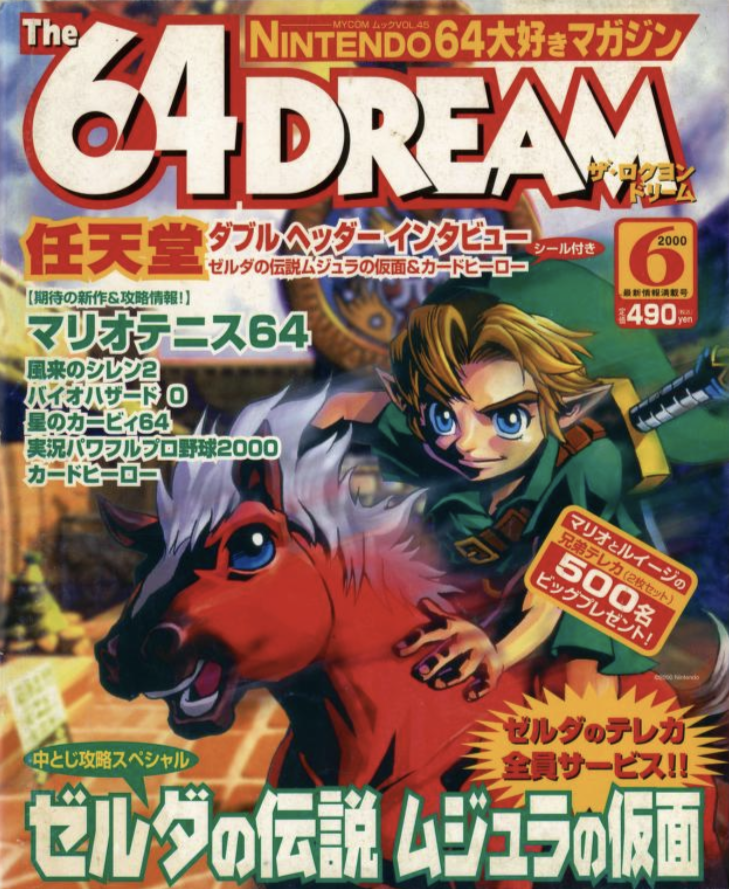
NINTENDO DOUBLE HEADER INTERVIEW
This month’s feature is a super special one! Amazingly, we have managed to get 5 creators from Nintendo. The first match/interview is [with the team behind] the long-awaited N64 game, The Legend of Zelda: Majora’s Mask. The second match/interview is [with the creators of] the popular Gameboy game, Trade & Battle: Card Hero.
Dive into the passion and philosophy of these super game creators who are responsible for these two titles.
The first of our double-header interviews is with the team behind the long-awaited Majora’s Mask. We had the pleasure of talking with, of course, Mr. Miyamoto and for the first time, two other directors[, Mr. Aonuma and Mr. Koizumi] about the hot-out-of-the-oven new Zelda title.
Producer of The Legend of Zelda: Majora’s Mask
Mr. Shigeru Miyamoto
・Director of the Information Development Department. He was born in Kyoto in 1952. Although he was deeply involved in the nitty gritty of creating The Legend of Zelda: Ocarina of Time, this time he focused on being a producer. He says he achieved his goal of “not being the one to write all the specifications.”
Game System Director of The Legend of Zelda: Majora’s Mask
Mr. Eiji Aonuma
・Member of the Information Development Department. He was born in Nagano in 1963. He joined Nintendo in 1988 after graduating from the Design Department of the Tokyo University of the Arts. His notable works include Marvelous: Mōhitotsu no Takarajima and Ocarina of Time.
Game System Director of The Legend of Zelda: Majora’s Mask
Mr. Yoshiaki Koizumi
・Member of the Information Development Department. He was born in Shizuoka in 1968. He joined Nintendo in 1991 after graduating from the Department of Film Studies at Osaka University of the Arts. His notable works include Super Mario 64, The Legend of Zelda: Link's Awakening, and Ocarina of Time.
Producer Miyamoto with an Experienced Team
Interviewer: Mr. Aonuma, Mr. Koizumi, you both were involved as directors for Ocarina of Time, right?
Aonuma: For Ocarina of Time, I led the development of dungeons and enemies. But for some reason, this time I ended up doing the main direction.
Miyamoto: For some reason (laughs).
Koizumi: Last time, I was in charge of the player character… [I mean, I was in charge of] Link's character design and animation. This time, I'm directing sub-events and scheduled events like the ones in the Bombers' Notebook.
Interviewer: Mr. Koizumi, you've been with Mr. Miyamoto for quite a long time, haven't you?
Koizumi: Yeah, although the entire time all we have made are Mario and Zelda so if feels about time to…(Laughs)
Miyamoto: He said he wanted to do it on his own this time, so I let him loose.
Interviewer: It seems like you went with a multi-director system this time, just like in Ocarina of Time, but with Mr. Miyamoto focusing on being the producer, who was actually leading the directors?
Aonuma: We needed someone to lead, and when I said [just to get the ball rolling], “Shall we go with this?” Everyone said “let’s go with that,” and the roles fell into place.
Miyamoto: I mean, he is the next oldest after me, so…
Aonuma: Yeah it’s based on seniority (laughs)
Interviewer: Did any of the producers give you feedback or direction after you had made a final decision, Mr. Aonuma?
Aonuma: No, not really. I was given quite a lot of freedom this time. I was entrusted with most of the decisions until basically the end of development when Mr. Miyamoto gave us corrections [and feedback] like: "Hmm, that's not quite right," on some of the finer details. Miyamoto really didn't interfere this time. At the very end of everything he came in as a player for just a little bit, but that was about it.
Interviewer: What was the reason you didn’t “interfere,” Mr. Miyamoto?
Miyamoto: Probably the biggest reason was that I felt it was going to be okay even if I didn't say anything. Additionally I was really quite involved in deciding the initial framework [or outline for the game]. Once that was all decided and fixed, I looked at my team members, and I felt reassured [I could leave it to them]. I mean, they are the same people who worked on the previous title right? The only two who had left the previous team were me, because I decided to quit getting into writing the nitty gritty specifications, and Mr. Toru Osawa who was in charge of the script. If I was to get deep into the development work with lots of little details, after we had decided the outline for the game, it would have been… [more troublesome than dealing with] family matters (laughs)
★ Mr. Aonuma was a director on one of the last games for the SNES, the masterpiece "Marvelous" (1996). It was an adventure game full of Zelda-style puzzles.
Aiming to Make a New Game with the Same System
Interviewer: After finishing the previous title, how did development for Majora’s Mask begin?
Miyamoto: Well for starters, Ocarina of Time was commercially successful, so there was a discussion about how it would be nice if we could release the next game within a year instead of having to wait for 3 more years. But the plan was to make the next titles for both Zelda and Mario after the hardware had been improved, and there hadn’t been any new development on that end since the previous work. But we thought, if we can use the memory expansion that was planned for the 64DD on the N64, then we would be able to do a lot that we couldn’t before. Also when we finished Ocarina of Time, I had really wanted two more months [to work on it]. We lacked [the time for] fine-tuning and refinement. So we started to imagine how if we spent an entire year on details and fine tuning, we might be able to create a really amazing game. That’s where the plan started, but we ended up creating something totally different, and [now that it's done] I’m still saying, “If we only had two more months…” (laughs). Even so, we started talking about the idea in December of 1998, right after Ocarina of Time was released, and planning officially started in January with full on development starting in February… So, we really did manage to get it done in a year. You could play two full Zelda games while still in middle school, it was quite the dream (laughs). As my own children approach that age, I really began to feel that waiting 3 years for the next Zelda would really be tough [for them].
Interviewer: When you say that you spent a year working on refining and [getting the most out of the] same system, what do you mean in terms of specific tasks?
Miyamoto: We wanted to evolve the game system. I didn’t want to spend most of our effort on creating things like secret dungeons. 60% of the work of making a video game are tasks that you have to do like the name registration screen or the ending credits sequences. We were able to reuse most of those parts from Ocarina of Time and put our full power into designing the new aspects that would be the structure of the game. So in that sense it is an entirely different game. And also there were many things that we weren’t able to do in the previous game… For example, we called the detailed work on characters the story, but the detailing on the characters was lacking. So this time, we put a lot of effort in creating each character from the very beginning.
Aonuma: For things like Link’s movement, they were already basically completed for Ocarina of Time, so we didn’t need to spend time redoing them. Instead, the idea was to use those as a base and create different gameplay options. The thought process was about using what we have while changing certain aspects to create a game with a different look and feel.
★ Despite what the developers say, various details about the game have been changed. For example, this is a new movement where Link does an auto-jump [across a gap].
How to Make it Different from Ocarina of Time
Interviewer: I was really surprised when I found out that the world had been completely changed. I had totally thought it was going to be set in Hyrule…
Koizumi: Initially that is what we talked about doing. But when we actually started working on it, it turned out that swapping things around was actually easier. The designers have really developed their skills, and their work is much faster. So anyway, this time the focus was on where to show how the game was different from Ocarina of Time. Even if it is the same grassy field, we wanted to do something different with it… Something like using a more vibrant color palette or making strangely shaped trees. The towns, which were inspired by medieval Europe in Ocarina of Time have more of a Southeast Asian style this time. It wasn't just about the visual design; the goal was to create something that was really different from the previous work. Creating a new world actually boosted morale.
Interviewer: So it was kind of like you created a hurdle that you had to overcome. For Ocarina of Time You had ended up setting a very high bar for yourselves as well.
Koizumi: Oh yeah, but there were a lot of young people involved this time, and it seems like the higher you set the bar, the more young people are going to [take it as a challenge and] think, “Just watch me!”
Aonuma: Everybody had something about which they felt “I wanted to do it, but I couldn’t in the previous work,” so there was a sense of “this is our chance to really do it.”
Koizumi: Everyone has their own idea of how the world of Zelda should look. But if it's a "side story," then it felt like we could deviate from that worldview. It was certainly a high bar, but it was also like, "Why not try jumping in a slightly different direction."
Interviewer: Mr. Miyamoto often talked about wanting to create "landscapes that don't seem of this world," when talking about Ocarina of Time, but in terms of a Zelda-like atmosphere, it feels even stronger in this game.
Miyamoto: That’s right. In the previous game, I was focused on realism with maybe a bit of distortion, but with Majora’s Mask we had already achieved that [so we could do something different].
Interviewer: Thinking about it now, the world of Ocarina of Time was maybe a bit too stylized (laughs).
Miyamoto: Well at the time, Final Fantasy was really popular so (laughs).
Aonuma: In Ocarina of Time, there was a conscious effort to make it look cool, but this time it's a bit more on the goofy side.
Miyamoto: When the first draft of the plot was finished in around March 1999, I rejected it. There were 8 dungeons… I’ve talked about this before, but after playing up through the 4th dungeon, you have people who think, "There's still half left?" and you have people who think "There's only half left?" It’s the amount [of game]… We decided to add a second theme to our development, we decided to quit making a game where players can only play the amount of game that we decided and created. So we trashed the original plot draft that was based on “stacking up an even higher hurdle on top of the one for Ocarina of Time and overcoming it.” Instead, we decided to make a game at the level where people could play for as long as they wanted: it's fine to only play for 2 days, and it's fine to play for a month.Which meant that the bar was now “how do we make sure the game is interesting?” Everyone was enjoying the work while saying things like, "What are we going to do if it's not interesting?" but we all felt that if we are going to do it, we had better put everything we had into it.
Interviewer: Did you also have the feeling this time of "Let's create something completely new, regardless of whether it's interesting or not?”
Aonuma: Yes, there was some of that. But because we were doing something no one had done before, and we since didn’t know how people would react, we really wanted to make sure it was at least fun and interesting to play. But we weren’t getting feedback on if it was fun or not, so we were really filled with anxiety. But I personally was able to try tweaking various details, and [get it to a place where] I was thinking “if we do this then it should be fine.” And by the second half [of development], I began to see, to some extent, whether it would work or not. But then I would start thinking, "What if I tweak this part?" and ended up making significant changes to the system… The final game ended up being really a product of trial and error.
Koizumi: It was quite the challenge to stick the landing.
Aonuma: Yeah, until we decided what kind of game we were making and got the system working well, we kept tinkering with everything until the end [of production].
TWO GAMES IN ONE
MAJORA’S MASK IS FUN EVEN
ON REPEATED PLAYTHROUGHS
Originally you had one week before the moon fell [into Termina].
Interviewer: So for this Zelda, how did the concept of “playing over and over again in a limited amount of time” come about?
Aonuma: As Mr. Miyamoto mentioned earlier, it was going to be impossible for us to make a large game in under 12 months. So we had to figure out how to make something more compact. We decided we could manage to do about 4 dungeons in under a year, but to avoid the game becoming something merely small, we considered incorporating something new… the idea we came up with was how do we create a system where the same events are going to happen in the same place, but by doing something differently, [the player could influence the game,] and have a different experience. That’s where the idea of “the game resets in 3 days, but each time the player goes back to start, their experience [and what they can do] expands a little bit” came from.
Miyamoto: Initially, it was one week. We called it the “one-week system” and were talking about fitting the game into one week. But about 3 months in development, we realized that it was a bit too long, and changed it to be only 3 days… Even then, we felt 3 days was [going to be] too big. Take Ocarina of Time for example, that game took about 60 hours to complete. So people would ask “How many hours of playtime are you planning for this game?” we would respond with something like “Around 80 hours…” and they would invariably follow up with “So the Dolphin game will be about 100 hours?” and we would have to reluctantly say, “Yes…” I really started to feel like we would be working non-stop forever (laughs). So for this game, I don’t want to say how many hours it is, instead I want to say something like playtime entirely depends on the player. That was something that came up in our discussions: the job of Nintendo is to come up with the best game system to create that kind of play. So, because of that, the direction for the game system was pretty unanimous. Instead of making Ganon more menacing and having him appear in a typical game, we wanted a world where the one-week system could be effectively utilized, and where characters from the previous game could reappear in different roles. Once we had that, the various elements came together in a natural way to form the current story and gameplay… After that, it was basically the task of getting the most out of everyone’s creativity. By leaving in the classic [Zelda gameplay], the new parts [of the game] really stand out
Interviewer: While we have the four dungeons of a classic Zelda game, it feels like there is a totally new second game in the Bomber’s Notebook. Was there ever a discussion going out on a limb and completely removing the four dungeons?
Koizumi: Initially, there was some discussion about doing that, but as long as the game has Zelda in the title, people who played the previous game are likely to buy it, so we wanted to keep the regular dungeons. However, unlike Ocarina of Time, time still flows even within the dungeons. So the conundrum of things like when to play the Ocarina and wind back time is new. Like, it’s easy to cut dungeons; everyone wanted to see if we could change the way people played by keeping them in the game. That desire was a catalyst for ideas like having time continue to flow while in a dungeon.
Aonuma: Having some similarities and some differences makes the new aspects of gameplay stand out even more. Even if you play the game focused on just clearing dungeons, you have to be conscious of the three-day time limit, so the way you play needs to change significantly from how you might have played Ocarina of Time. That's why we kept the dungeon-clearing aspect as the main story; it makes the new system really feel new. Initially, we did talk about stopping time inside the dungeons, but it didn’t feel “right,” and we eventually decided to let time flow throughout the whole game. We wanted to keep some aspects similar to the previous game but make the overall experience feel completely different.
Miyamoto: You have to take into account the stance of the developer. We often get into discussions, but our stance as a developer needs to be clear. It's not a sense of duty to the industry, but we want to be clear about what we are making games for. And after we have managed that, in the end, games are entertainment, so we want to create games that users can play without getting frustrated [or annoyed].
[Dialogue] “Do you have any problems? Any? If you do, tell it to us Bombers! Tell us!”ut
★ Time only stops in the game when the pause menu is open, you are talking to someone, you are using the ocarina, etc.
Miyamoto (cont’d): Although we do get some complaints from users, [we released the game] in the full knowledge that even when we play the game there are many moments where we think, "This is unfair." That's why I wanted about two more months; I wanted to find a way to make things a bit less arbitrary. But on the other hand, if we started by removing those arbitrary elements from the beginning, saying something like, “Zelda games are thinking games, so we should stop time in the dungeons," then people might start saying, "Well why not just remove dungeons altogether?" That is the gamble right? We worked hard until the end to ensure that players are satisfied and enjoy the game even when it feels unfair or arbitrary. Thanks to thoroughly sticking to that approach, I think we created a unique style of game, and it has worked out well in the end.
Once you have become a “Time Master,” the Bomber’s Notebook gets [really] interesting
Interviewer: Do you have to switch between the main story of clearing dungeons in the traditional Zelda style and the notebook events, or can you play them independently?
Koizumi: There's no need to switch. The notebook is also for players who have already cleared the game once and want to aim for completion by playing it again.We think that is a totally valid way to play the game. The goal was to create something that was enjoyable for players after they had gotten used to the system of playing the ocarina to rewind time. We created it as a feature to extend the player's time in the game, after they have cleared the 4 dungeons and reached a good stopping point in the story. To be perfectly honest, we made it so that you can watch the ending without even obtaining the Bomber’s Notebook, and then decide “Well, let’s collect some masks” and play through it all again.
Interviewer: In terms of [it still being] a Zelda game, are there events in the Bomber’s Notebook that you can’t complete unless, for example, you have already completed the third dungeon?
Aonuma: The events in the town and the story revolving around the four dungeons are completely separate… Or well, there is some connection in terms of content, but they are designed to be played independently. Town events take place in town, and events related to the dungeons are contained within those regions.
Interviewer: From a development perspective, how do you weigh the importance of the traditional dungeon-clearing game versus the Bomber’s Notebook-based event game?
Koizumi: Although we worked hard to create the notebook portion of the game, we still think of it as a side feature. We think the main part of the game is the standard [dungeon-based] storyline that players will engage with. But if players only focus on the dungeons, they are not going to understand the true appeal of the three-day system. It is a world governed by the three-day schedule, but, for example, if the entrance to a dungeon only opened on the first day, that would make the game much less enjoyable right? So, while players can enter the dungeons at any time, we kept the ocarina time-rewinding rule the same, and once they have cleared the 4 dungeons and gotten used to the system they should start to think of themselves as a “Master of Time.” It’s at that point that we want them to return to the town and complete the events.The town events have a much more strict schedule. In the town for example, a certain character will only appear on the second day in a certain place at a certain time. I think it would be pretty overwhelming to jump right into doing the Bomber Notebook events, so we suggest that players clear the main dungeons first as an introductory course to becoming a “Master of Time.” If the players take on the Bomber Notebook events after they have gotten used to the rules of the world, I think they are more likely to appreciate the story [and the system].
[In-game Text] Gorman, leader of a traveling troupe. Has fine clothes, but a frightful face it stand out
★ For people who have the question, “What actually is the Bomber’s Notebook?” turn to page 59~ The appeal of the three-day system is on full display here.
Aonuma: To be honest, I wanted to add more time-related ideas into the main route because that would surely make it more interesting. But if we had actually done that, it would become very challenging to clear dungeons and the players would get mad and say things like, “All the game does is cause more stress,” which is pretty frustrating (laughs). I’ve had to accept that the main [dungeon-based] storyline has that role [of introducing people to the 3-day system]. Now I just hope that players will, if they find themselves kind of stuck in a dungeon, stroll and look around the town, maybe stalk someone for a bit, and realize, “Oh! At this time this character is meeting with that character.” Or while idly wandering the town, a player might suddenly realize the solution to the puzzle in the dungeon and go back to the dungeon and try again.
Interviewer: Since it is like having two games in one, you have given the players a lot to think about, no?
Miyamoto: I think it’s the kind of game that gives you trouble as you play it: it’s omotsurai (a word created by Shigesato Itoi combining the Japanese words omoshiroi and tsurai). Something like when you get tired of playing the game, instead of doing something else, you end up playing it more (laughs). In terms of percentages, I think that classic Zelda gameplay is about 60% of the game, familiar side quests are about 20%, and the Bomber’s Notebook makes up the last 20%. I think it is perfectly fine for players to complete the 4 main dungeons and then as they work on clearing the side quests and the Bomber’s Notebook events, the progression will get easier. Pushing blocks in dungeons isn't what makes Zelda fun; it's about creating a sense of participation in the player when they push a block, a sense that gets the player to think, “I wonder what is going on right now in the world.” That’s what I think the story is supposed to do.
It’s a game that gets more fun the more times you play it
Miyamoto: I think that a Zelda game should be a game that is more fun the more time you play it… So take a game like Ocarina of Time…My biggest regret with that title is that you can’t battle the dungeon bosses a second time after you defeat them. Even though it would be more fun to fight them twice, there is no reason to go back [to the dungeon]. [With Ocarina of Time] we saw that as an issue, and so for Majora’s Mask we made sure that players can replay the dungeons as many times as they want, and they can battle the bosses to their heart’s desire. I think the ideal scenario is where by playing the game over again, a player’s sense of the game’s world expands [to beyond what they could have experienced in a single playthrough].
Koizumi: After getting the Goron Mask, for example, you could go back to the first dungeon and try clearing it again. By changing up which items and masks you use in the dungeon can replay the game in various ways [like finding unique solutions to puzzles or new shortcuts]. Trying out a different mask on an old boss to see if the boss fight is easier or something…
★ If you want to, you can battle the bosses as many times as you want. In Ocarina of Time your only option [to battle a boss again] was to replay the whole game, so this an exciting [new] system.
Aonuma: Although when you turn on the game the starting point is the same every time, after you have cleared it once, you can easily get back to where you want to go, and try various things. The people who say that it is annoying might be right, but I think that there are plenty of people who will take it as it is and think to themselves, “I get it now, what a convenient game.”
Miyamoto: This time, we are totally fine with magazines revealing dungeon maps and solutions to the puzzles. It’s not a game about discovering the secrets of each dungeon, I mean that is one part of the game, but some parts of the game get more interesting only after the dungeon has been completed. I don’t think that the fun of Majora’s Mask can be spoiled just by publishing the dungeon maps.
★ Although [the devs] talk about repeating the game, as you play you will learn useful things like the warp movement system, so no need to worry [about it becoming a slog]. Master the common-sense-defying save system
WHEN THE THREE-DAY SYSTEM BECOMES SECOND NATURE, YOU WILL HAVE BECOME A “MASTER OF TIME”
Master the common-sense-defying save system
Interviewer: Many players are going to come to the game assuming that it is very similar to Ocarina of Time, right? Don’t you think they are going to have a tough time with the three-day system? And then [what will they do]...
Koizumi: I think we pulled off a good betrayal with that one (laughs).
Aonuma: It’s one of those betrayals that you only understand after you’ve tried it once. I’m sure you’ll hear a lot of people going “Hunh?!” after they experience it.
Miyamoto: I really wanted to make a game that takes 80 hours to complete but can result in a Game Over within 2 hours. I wanted to make sure that the players experience at least one Game Over. Something kind of like going to watch a grand epic film like Gone with the Wind and then, thirty minutes in, the main character dies. You’d be like, “Hunh?! What’s going on??” (laughs). After you play the game again, you’ll realize, “Ah, that was my fault,” and I think that gives the game a really interactive feel to it. I wanted players to feel like, “Ah, yeah I was messing around over here…” Initially when you got a game over, we would return the game to the title screen, but that was a bit too… (laughs). When we had people test the game, everyone would just keep staring thinking it was the ending screen (laughs). [I ended up thinking] doing it like that was a bit too rough [for the players].
Interviewer: In my first playthrough, the moon fell once…
Miyamoto: All according to plan (laughs).
Koizumi: Yeah, the player has to die for us at least once (laughs).
Interviewer: About the save system, it must have taken some guts to decide that was how it was going to work…(For details on the save system, see the article on page 60).
Aonuma: Yes, indeed.
Interviewer: For example, you are in the early stages of the game, let’s say you manage to reach the Deku Palace on the boat cruise, but you didn’t manage to complete the Inner Palace Garden section, so you think to yourself, “I’ll try this again tomorrow,” and you save [and end the game]. Then, the next day, you turn on the power and you realize, “you have to do the boat cruise all over again!? And what’s worse, all of your consumable items are gone?!” I’m not wrong thinking that is a totally possible scenario, right?
Koizumi: Accepting that as part of the game is step number 1.
Aonuma: These days, it’s common sense now for a save to save all of your items isn’t it? But what's the problem with creating a save system that doesn’t follow conventions? This game teaches you the habit of not taking saves for granted, and once you get used to that it becomes all the more interesting. We want people to remember that, “This is how this game is and there’s just no helping it,” (laughs).
Miyamoto: As an excuse, if the technology was a bit more advanced, then we might have been able to consider a save-state that saved everything, but that wasn’t possible. But if you could save that way and restart from the save point over and over again, then it wouldn’t be the same game.
Aonuma: We want players to discover that even though their consumable items have been set back to zero, they will be able to recover with the various things that we have built into the game. When you turn on the power, we want them to think of their own route: first I have to go here to replenish my items, then I need to do that, and then this, and then finally I can enter the dungeon.
Miyamoto: When I played as a tester, there were times where I didn’t have enough in-game time to use the item that I had just gotten, or I would reach a location, save and then have to fight the boss all over again. Once you get used to it, that becomes part of the fun though (laughs).
★ When you save and turn back time, time will flow backwards and Link will fall separately from all of his consumable items (laughs). Try not to drop anything~
Once you get used to it, you will be able to control time freely with the ocarina
Interviewer: How much actual time passes compared to the flow of time within the game?
Koizumi: One day in the game is about 18 minutes of actual time.
Miyamoto: Demos and conversation scenes both stop time, so playing through the three days takes around 1 hour 30 minutes to 2 hours.
Interviewer: How did you decide on an hour and a half?
Aonuma: Well… We didn’t have enough time to do very meticulous testing, so we tried playing the game with various time lengths and this duration felt about right… We were thinking about how long someone could stay concentrated on the game, and various other factors that we had realized over time, and like the appropriate amount of shock when the moon falls causing a game over…etc (laughs). We took a holistic approach to setting the duration.
Koizumi: I would say that it depends on how each particular person perceives the speed of time passing. Waiting can make the time feel longer, but when something is chasing you the passage of time can feel short. Once you get used to manipulating time with the Ocarina, you will really start to feel as if you are controlling time.
Interviewer: If you are looking for good timing for saves, an hour and thirty minutes might feel pretty short.
Aonuma: Indeed, when you are doing something new, it feels short, but for the parts that you already understand it can feel [too] long.
Miyamoto: If you consider total playtime, you can play in ways and strategize your own approach because you don’t need to spend time doing unnecessary grinding like in an RPG. Of course we had to sacrifice some aspects of the game to implement the 3-day system, but we were able to create something [really quite] new… While I'm fighting a dungeon boss, I think, " Anju is doing that thing right now isn’t she," and it gives me this unique kind of satisfaction playing the game. In the game industry, we've been talking about multi-endings and multi-stories for over 10 years, connecting games to things like movies or novels, or adding in or not adding more side quests etc. Depending on the route each player takes, their memories of the game will be different. I think we are the first to have achieved that multidimensional aspect [in a game].
★ If the shortness of the three days is giving you trouble, it might be a good idea to talk to the scarecrow. If you are ok with spoilers, check out page 65.
I WANT TO KNOW MORE ABOUT MAJORA’S MASK
◆Going Back in Time◆
Interviewer: So it’s not possible to rewind time to a specific point?
[Blank]: No, it’s not possible.
(Note from translator: I think the names here are blank because of a misprint, but am not sure. Anytime the speaker’s name is missing I have shown it in this way)
[Blank]: If you could undo what you've done, it would, ultimately, ruin the whole playthrough. Instead of doing that, it’s better to have players start over from the “Morning of the First Day.”
[Blank]: Even if it were possible, the question is whether it would be enjoyable to instantly go to a specific day, hour, and minute.
Interviewer: When doing the Bomber’s Notebook side quests, I think there are plenty of people who long for such a feature. Like, “Oh wait, I need to go back to this past hour!” or wishing to be able to stop time since they are unable to make it in time for a scheduled event…
[Blank]: It exposes how you are in your personal life doesn’t it? I am always arriving early for appointments, spending my waiting time cutting grass, or going into a nearby room to pass the time, only to find that the event has ended by the time I come out (laughs).
◆Travel Speed and the Size of the World◆
Koizumi: One of the things we focused on when creating the transformation characters (Deku Link, Goron Link, and Zora Link) was how to handle their movement. Flying, rolling, swimming... on land, sea, and in air. Since time is essential in this game, movement speed is crucial. For example, by using Zora Link's "swim," you can move significantly faster than running with the Iron Boots. I thought that by shortening travel time in this way, the game would feel better as a game limited by the flow of time. If you use each character's unique abilities well, there are many shortcuts you can take in terms of movement and speed.
Aonuma: Unlike in Ocarina of Time, we've tried to avoid having areas that have no triggerable events. We have put some sort of event in every area. Not just small things but events that require a certain level of progress to access. So, while the size of Hyrule is the same; it is much more densely populated.
◆This Zelda Game Has Horror◆
Koizumi: Rather than horror, it’s more about strangeness. The world's setting itself is bizarre. The peculiarities and eerie occurrences in each region give an impression of getting close to unapproachable alien beings. On the other hand, in the towns where ordinary people live, we've depicted the shadows at the level of daily life... Although the elements that might seem strange to children and adults are different, we have made sure to weave both aspects into the game.
[Blank]: We made a game that can’t be mocked as “just a children’s game,” we created something that deserves adult appreciation as well. If you equate the term "horror" with the horror in games like Resident Evil, then of course it's a different kind of game. Mixing us up with that is a mistake… But, when you're running out of time in front of the boss room on the third day, it's scary. You start thinking, "Will I make it to the save in time? What should I do with this data?" (laughs). Recently, I didn’t have time to get to the bank before I saved…and I started thinking, “But then what should I do about these 50 rupees?” (laughs). I panicked and screwed up the song… (laughs).
★ The moon’s face is the epitome of strangeness. We actually wanted to make it even bigger on the third day.
◆Expansion Pak◆
Koizumi: In a bunch of different ways, you could say we went all out with using the Expansion Pak for the town.
Aonuma: Like for various character movements. Not only for actions during conversations and in demos, but we were finally able to give each character a lot of different expressions and detailed movement animations. Giving that many motions to each character increases memory usage. Without the extra memory it would have been impossible to have a character constantly on-screen moving around. And we also used it to manage the time for each character's movements, increasing the number and complexity of enemy characters in dungeons...
Miyamoto: Also the landscape and background. We're using it to improve the quality of the art.
★An example of a character on a movement rail. Try stalking them as they move around.
◆The Missing Sages◆
Aonuma: (While looking through the “Anything Goes Zelda Ranking” results published in the 1999 April edition) The characters that made it into the top here don't appear in the game, do they? Saria wasn't even included...
Koizumi: That’s true. We delved quite deeply into those characters in Ocarina of Time. Also, they're characters involved in the classic Zelda story, so introducing them into a different Zelda world might feel out of place. Instead we decided to present characters who weren't deeply explored in the previous games. We gave them different [backgrounds and] settings to capture the feelings of the people who voted for less popular characters.
Interviewer: Anju (the Cucco Lady) only got 6 points in our magazine’s rating contents, but she has one of the most involved sidequests doesn’t she?
Aonuma: That's the part where Mr. Koizumi put in the most effort (laughs).
Miyamoto: It was a full-power throw (laughs).
Koizumi: Well, um... I personally liked her a lot (laughs).
★ Don’t miss out on experiencing the subquest that Mr. Koizumi poured his whole soul into!
◆Tatl and Navi◆
Aonuma: Before the player obtains the ocarina, we have Tatl give a lot of hints and tips. Getting the ocarina marks the point where the game truly begins, so we added hints to the point where it's basically telling the player to not think about anything and just follow what Tatl says down the only path available. From there on, various approaches are available for the players. If we were to continue providing hints, players would naturally move in the way we suggested [through Tatl], and I didn't want that. When you return to the start point, Tatl will briefly mention the need to clear the four dungeons, but afterward, it's all about freedom. While we do have some hints provided at specific locations, we've tried to avoid extensive guidance.
Koizumi: Navi was more like a doting wife who does everything, but we decided to make Tatl more like a brusque older sister. Doing that actually made it easier to provide hints. Instead of saying something like, “What if you tried to do this?” it is more like “Do it this way!!” [which is a lot more clear].
Aonuma: The one in charge of [writing] the messages likes [strong-willed], straight-talking women (laughs).
Koizumi: Everybody likes them (laughs).
Aonuma: Everybody wants to be scolded a bit (laughs).
[Vertical Writing Down the Right-Hand Side ] BREAKING NEWS: Film star, Robin Willam’s daughter’s name has been confirmed to be “Zelda.” The truth on this matter will be presented on the May 4th broadcast of TBS’s Hanamaru Market, so it’s a must-see for Zelda fans!
For any feedback or to just join the community, jump into our discord: https://discord.gg/T8Gn62Jr

























